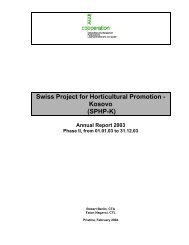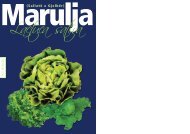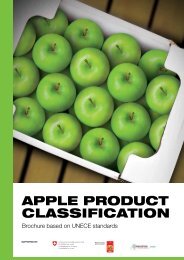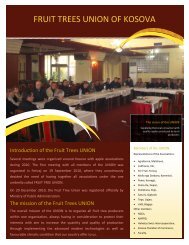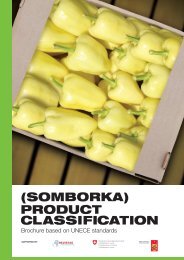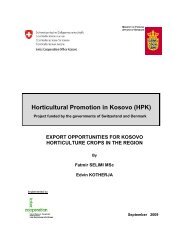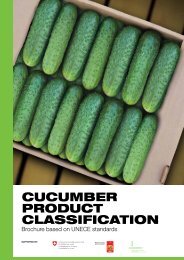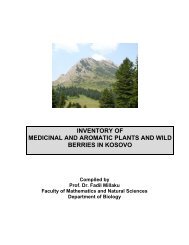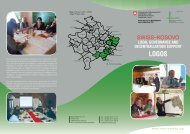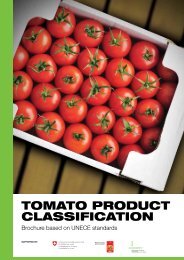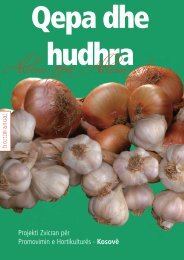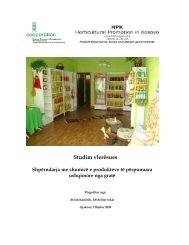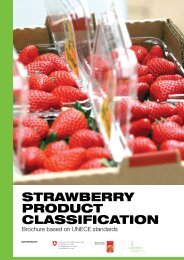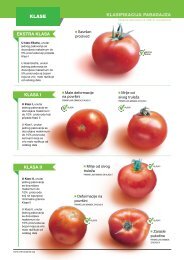bedding plant industry - HELVETAS
bedding plant industry - HELVETAS
bedding plant industry - HELVETAS
- No tags were found...
Create successful ePaper yourself
Turn your PDF publications into a flip-book with our unique Google optimized e-Paper software.
CAPEXCAPITALIZATION OF EXPERIENCESDEVELOPING MARKETS THROUGH BUSINESS LINKAGESThe case of the<strong>bedding</strong> <strong>plant</strong> <strong>industry</strong>in KosovoD E C E M B E R 2 0 0 4Swiss Project for Horticultural Promotion - KOSOVO
Time FrameImplementationPartnersFinancingLocalizationTarget Population2001- todaySPHP-K 1 / IntercooperationSwisscontact, PUMSwiss Agency for Development and Cooperation SDCKosovoPilot farmers, farmer groups/ associations/ enterprisesAuthor Robert Berlin 2Collaboration Nora Gola 3 , Luan Hoti 4 , Henri Conrad 5INTRODUCTIONThe production of seasonal annual <strong>plant</strong>s used to be very small in Kosovo during the formerYugoslavia. Bedding <strong>plant</strong>s as well as ornamental trees and shrubs were mainly producedby state- owned companies that maintained public parks, possessed flowershops, and exchanged products with different Yugoslavian enterprises.After the war a private sector started emerging and was from 2001 supported by SPHP-K. In 2004,the domestic production of <strong>bedding</strong> <strong>plant</strong>s accounted for approximately 250,000 and around28% of the total <strong>bedding</strong> <strong>plant</strong>s sold were produced in Kosovo. Production of the flower and decorative<strong>plant</strong>s in Kosovo are significative in the segments of:< Bedding <strong>plant</strong>s for gardens, balconies, and parks.< Ornamental trees and shrubs, but only to a limited degree, for private and municipal <strong>plant</strong>ing.1. S P H P-K is the SwissProject for HorticulturalPromotion in Kosovo.It is executed by INTER-COOPERATION ( IC) andfinanced by SDC2. Chief Technical Ad v i s e r,SPHP-K3. Horticultural and businessadviser, SPHP-K4. Marketing adviser, SPHP-K5. Marketing specialist,IntercooperationThe domestic production is spread in whole territory of Kosovo.In 2001, assessment of the subsector has revealed that there were onlytwo private nurseries in Kosovo producing <strong>bedding</strong> <strong>plant</strong>s and othertypes of ornamentals. Additionally, there was no locally produced substrateavailable and nurseries were producing a relatively poor quality substrateby themselves.Today, around ten new producers have started to produce seasonal annual<strong>plant</strong>s for gardens, balconies, and parks and two of them made an initialstart with indoor pot grown <strong>plant</strong>s and cut flowers. It is worth noting that,two of the new prod u cers – La b i , Ag rounion- are also establishedimporters. And two companies supported by SPHP-K started the productionof worm compost and industrial compost.The assessment of subsecto r’s co n s t ra i nts and oppo rtunities reve a l e di m po rt a nt po te ntial for strengthening the domestic <strong>bedding</strong> <strong>plant</strong> <strong>industry</strong>.Swiss Project for Horticultural Promotion - KOSOVOThe case of the<strong>bedding</strong> <strong>plant</strong> <strong>industry</strong>in Kosovo1
Three opportunities to develop a viable <strong>bedding</strong> <strong>plant</strong> sub sector facilitatingbusiness linkages were identified and subsequently addressed:1 . The current business capacities for <strong>bedding</strong> <strong>plant</strong>s needs to be increased:< On the supply side, the flow of value-added products can be improved.Typically, well equipped commercial nurseries may supply growers with highquality seedlings and domestic compost factories may supply nurseries andgrowers with a more economic substrate. There are good opportunities forsmall producers (including women and minorities - generally less equipped) tocommercialize the growing-on of <strong>bedding</strong> <strong>plant</strong>s to point of sale. Finally, thereis the opportunity for importers and retailers knowing the market and havingcapital assets to develop their production capacities< On the demand side, t h e re is an oppo rt u n i ty to broaden the range of domestical ly prod u ced <strong>bedding</strong> <strong>plant</strong> s, to int rod u ced new va rieties and to develop news pe c i a l i zed markets e. g. cut flowe r, l a n d s caping and herbaceous pe re n n i a l s.2 . The current quality standards for ornamentals need to be improved. There is anopportunity for ornamental growers organized in a network to improve the qualityof the final product (<strong>bedding</strong> <strong>plant</strong>) through the use of plastic containers, etiquettesand compost based substrate in order to better compete with importedproducts.3 . Skills and knowledge (know how) within the ornamental sub sector needs to beimproved. For example, the lack of expertise causes important losses during thegermination phase (this has reached an average of 60%). Linkages with other playerswho can offer ideas, expertise, connections and markets may stimulate producersto develop new processes and/or improve production.There is an opportunityto establish business linkages between experienced seedling producers andnewly establish growers and to update commercial enterprises with the newesttechnology and with the latest market development in Western Europe productionpractices.Swiss Project for Horticultural Promotion - KOSOVOThe case of the<strong>bedding</strong> <strong>plant</strong> <strong>industry</strong>in Kosovo2
INTERVENTION OF SPHP-KSince 2001, within these framework conditions, SPHP-K has facilitated the development ofthe subsector and supported different actors with the overall aim to develop the marketof <strong>bedding</strong> <strong>plant</strong>s in Kosovo and therefore generate more income in the rural areas. Thesuccessive steps undertaken are described in table 1.During the first year the project carried on field and market survey and took the decision to supportthe ornamental <strong>plant</strong> sector. At the end of the year, the project organized a study trip inSwitzerland and created a nursery network to encourage interlinks between private nurseries, andhelp producers identifying new business ideas and opportunities.Du ring the second and third ye a r, o p po rtunities for inte rve ntions we re identified and seve nPa rt i c i p ato ry Te c h n o l og i cal Deve l o p m e nt (PTD) agre e m e nts we re implemented for the int rod u ct i o nof new species of pot grown <strong>bedding</strong> <strong>plant</strong> s,the establishment of three mini garden ce nte r s, the settingup of a small facto ry for wo rm co m post prod u ct i o n ,and the establishment of a local co m p a nyfor industrial co m post prod u ct i o n .As a first cro p, a small amount of Pe l a rgonium and Im p at i e n s(10,000 <strong>plant</strong>s) was succe s s f u l ly marke ted loca l ly and raised the inte rest of new prod u ce r s.From the end of the third year onward, emphasis has been given to explore opportunities forleveraged interventions for further expansion of the ornamental programme. On the supply side,two PTD agreements including capacity building and new technologies were implemented withwell established horticultural enterprises to develop the production and commercialization ofhigh quality seedlings. On the demand side, a group of thirteen growers, often with little flowerproduction experience were linked through the ornamental interest group and implementedPTD agreement to develop their capacities of growing <strong>bedding</strong> <strong>plant</strong>s. At the beginning of 2004,50,000 high quality seedlings of 15 different species of spring/ summer <strong>bedding</strong> <strong>plant</strong>s were purchasedat a 50% reduced price from the two newly established commercial seedlings producers.During the same period, a PTD was implemented with the newly established industrial compostfactory to improve the quality management of the compost and develop a susbtrate adapted tothe needs of the <strong>bedding</strong> <strong>plant</strong> <strong>industry</strong>. As a promotion tool,small quantities of this new productwere distributed directly together with the seedlings by the nurserymen.At the end of 2004,more than 30,000 seedlings were ordered directly to the nurseries, and morethan 150T of compost were sold without project’s intervention.These actions had different expected results:< Develop the domestic production of high quality <strong>bedding</strong> <strong>plant</strong> seedlings and introducethem into the market (the growers)< Develop the domestic production of a <strong>bedding</strong> <strong>plant</strong> substrate and introduce it into the market(horticultural enterprises)< Increase quantity of domestic produced <strong>bedding</strong> <strong>plant</strong>s and improve their quality< Introduction of new crops and species into the market< Create business to business linkages for exchange of experiences and transfer of knowledgeSwiss Project for Horticultural Promotion - KOSOVOThe case of the<strong>bedding</strong> <strong>plant</strong> <strong>industry</strong>in Kosovo3
Table 1: Recapitulation of the actions fulfilled and main AccomplishmentYear 12001Years 2-32002-2003Year 42004-ACTIONS FULFILLED DURING THE INTERV E N T I O NStep 1:Inve s t i g ation through farms and market surveysStep 2:Si t u ational analysis through the nursery client sStep 3:Pa rt i c i p ato ry planning of act i v i t i e sStep 4:St a rt up of act i v i ty including training and co financingof activitiesStep 5:Mo n i to ring and assessmentStep 6:Pa rt i c i p ato ry eva l u ation and planning of activities( 2 0 0 2 - 0 4Fu rther expansion of the Orn a m e ntal Prog rammeS caling up –re p l i cat i o nSUMMARY OF ACCOMPLISHMENT1. Decision of the project to support the nursery sector1. Selection of clients (ornamental <strong>plant</strong>s and compost)2. Definition of activities within the Nursery Network1. Study Trip to CH and identification of activities1. Implementation of activities within the NurseryNetwork (Compost manufacturing, container growing<strong>plant</strong>s, garden center)1. Technical assistance2. As s e s s m e nt of the te c h n o l og i cal and market po te nt i a l1. Demonstration to other farmers2. Selection of the ornamental sector for Project’sintervention with 13 clients1. Ornamental interest group with 13 members2. Two nurseries selected to produce seedlings3. Introduction of 15 species amongst 13 growers4. Compost development and assessment5. Promotion of quality standards6. Assessment of the new species and varieties7. Capacity building1. Focus on seedling production.2. Promote joint marketing3. Development of new products4. New crops (herbaceous, perennials, cut flowers)5. Capacity building (landscaping, techniques,marketing, management)During the Project’s intervention,ornamental producers have requested various types of businessservices. In addition to the technical, methodological, marketing support received from SPHP-K,pilot farmers received services and support from private sector, other NGOs, donors, government,family and banks ( Table 2).Swiss Project for Horticultural Promotion - KOSOVOThe case of the<strong>bedding</strong> <strong>plant</strong> <strong>industry</strong>in Kosovo4
Table 2: Business Services received, by Ornamental <strong>plant</strong> producersand facilitated by SPHP-K during the period 2001-2004BUSINESS SERVICES CATEGORIES PROVIDER CLIENTS FUNDING FORMTraining and technical assistanceW = WomenM = MenTrainings and te c h n i cal assistance for <strong>bedding</strong> <strong>plant</strong> SPHP-K, consultants, 5W, 8M SPHPK,p rod u ce r s, and co m post prod u cers (3,000 ) senior expert 2 co m post companies Swisscontact, PUM SubsidizedAdvice to <strong>bedding</strong> <strong>plant</strong> producers Nurseries 5W, 8M Clients Em bedded serv i cesProduct DevelopmentI n t rod u ction of new species and te c h n o l ogies (9,000 ) SPHPK,nurseries, prod. 5W, 8M SPHPK Co-financedCompost and substrate development (29,000 ) SPHPK, consultant, 2 companies SPHPK Co financedI n s t i t u te of Ag ri c u l t u reMarket AccessPromotion of Garden Centre (5.000 ) SPHPK,nurseries 3M SPHPK Co financedDevelopment of packages for compost, SPHPK,designer 6W, 17M SPHPK Subsidized<strong>bedding</strong> <strong>plant</strong>s (3.000 )Trade fairs, open days and advertising (2.000 ) SPHPK,fair organizer, 5W, 8M SPHPK Co financedTV, newspapersOrganization and managementFarm Management Trainings & Workshops (1.000 ) SPHPK 5W, 10M SPHPK SubsidizedInput SupplyLinking nurseries, compost producers with growers SPHPK,nurseries 5W, 10M SPHPK Non SubsidizedFinancialCredits Bank,family members 1F, 3M Clients Non SubsidizedDi re ct financial suppo rt from SPHPK for years 2001-04 we re 52,000 (56% for co m post and 44%for <strong>bedding</strong> <strong>plant</strong> s ) .These figures do not include financial costs due to staff suppo rt and te c h n i ca la dv i ce provided by Sw i s s co nt a ct and PUM.RESULTS & ACHIEVEMENTSTh e re are 3 impo rt a nt results to be ment i o n e d :1 . In c reased business ca p a c i ty2 . In c reased co m pe t i t i veness3 . Higher income and improved kn ow- howSwiss Project for Horticultural Promotion - KOSOVOThe case of the<strong>bedding</strong> <strong>plant</strong> <strong>industry</strong>in Kosovo5
1 . INCREASED BUSINESS CA PAC I T I E S< I m p roved business linkagesThe pro j e ct facilitated the establishment of new business linkages within the Value Chain for smallg rowers and SMEs.Small growe r s’ channel and nurseri e s : In this channel, small and medium growers (including twow i d ow led families) obtain their inputs from local providers (including domestic prod u ced co m-post) and purchase part of the seedlings from local nurseri e s. Input suppliers genera l ly prov i d ee m bedded adv i ce/ te c h n i cal suppo rt together with their prod u ct. Co m m e rc i a l i z ation is doneeither through local and we e kly markets or dire ct ly from the farm .S M Es channel: co ntains co m m e rcial prod u cers mainly targeting hote l ,re s t a u ra nt, business facilitiesand municipalities besides selling dire ct ly from their ente rp ri s e s. This channel is the strongest onein te rms of ca p a c i ty prod u ce d. It is impo rt a nt for this ty pe of ente rp rises to develop strong businesslinkages with their suppliers (local and inte rn ational) and with their clients (municipalities,h o tels and ente rp ri s e s ) .The two market channels re p re s e nt tod ay around 25 % of the local market of <strong>bedding</strong> <strong>plant</strong> s ;t h erest is still impo rte d. ( See fig 1)Figure 1: Soft fruits marketing channels in the Southwest KosovoUrbanConsumersMunicipalities, hotels,restaurants, enterprisesRetailersFlowershopsGardenCentres(3)Wholesalers150,000 pcTradersImporters1.800 000 pcGrowersSmallandmediumgrowers(5)100.000 pcHorticultural SME s(2)450,000 pcNurserySeedlingproduction50.000 pc(2)InputsupplyCompostproducers155 TLocal inputdistributorsInternational andregional suppliersof inputsCHANNEL 1:Small growers’channel10%CHANNEL 2:SME s channel18%CHANNEL 3:Import channel72%The case of the<strong>bedding</strong> <strong>plant</strong> <strong>industry</strong>in Kosovo6
I n c reased prod u ction capacitiesThe domestic prod u ction in 2004 6 was approx i m ate ly 500,000 <strong>bedding</strong> <strong>plant</strong> s ; for 2003 and 2002t h e re we re 210,000 and 125,000 <strong>plant</strong>s grown re s pe ct i ve ly. These figures show that prod u ct i o ncapacities have been multiplying by 4 during the last three ye a r s. Main factors enhancing the po s-i t i ve deve l o p m e nt have been new inve s t m e nt s ;n ew ente rp rises ente ring the market and a growingdomestic demand for outd oor landscaping and for pri vate balconies and gard e n .Co n ce rning co m po s t, out of a market volume of around 700 tons/ year impo rted ye a rly in 2002,two companies suppo rted by SPH P-K started the prod u ction of wo rm co m post and industri a lco m post in 2003 with around 35t and have increased to 155t their prod u ction capacities in 2004.Table 3: Development of the annual seasonal <strong>plant</strong>s and compost <strong>industry</strong> in KosovoUnity 2002 2003 2004Annual seasonal seedlings 7 Seedlings nd 10,000 50,000Compost (Industrial and Worm) 8 tons 35 155Annual seasonal <strong>plant</strong>s 9 Plants 125,000 210,000 500,000Table 4: Locally Produce Ornamentals - Presence in the market in 2004Feb Marc April May June July Aug. Sept. Oct NovBedding Plants Seedlings X XX XXBedding <strong>plant</strong>s XX XX X XX= beginning/end of season XX= peak of production< Di ve r s i f i cation of the prod u ctionBroadening of the range of local prod u ced <strong>bedding</strong> <strong>plant</strong> s, has been a main object i ve of Pro j e ct’si nte rve nt i o n s. In Ko s ovo, top loca l ly prod u ced <strong>bedding</strong> <strong>plant</strong>s are tra d i t i o n a l ly Pe t u n i a ,Pe l a rg o n i u m ,Ice Begonia and Vi o l a .In 2003 and 2004, the pro j e ct suppo rted the int rod u ction of less kn own cro p sl i ke Ag e rat u m ,Ta g e te s, Sa lv i a ,Di a nt h u s, Zi n n i a ,Se n e c i o, Da h l i a ,Fuchsia and Ve r be n a .6. It is difficult to compiledata on, or even to estimate,total domestic productionof annual seasonal<strong>plant</strong>s since there aremany unregistered individualproducers who do notreport their sales to anyone.Nevertheless, theProject estimated that thedata that are coming frommembers of the ornamentalinterest group representsaround 70% of thedomestic production.7. Production quantity averagecommercialized: nodata for year 1, 10,000 foryear 2, 50,000 for year 3.8. Average production: 30tons for year 1, and 150tons for year 2 for industrialcompost and 5t/year forworm compost.9. Production quantity forlocally grown <strong>plant</strong>s is thesame with the locallygrown seedlings.A major constraint for the development of the <strong>bedding</strong> <strong>plant</strong> <strong>industry</strong> isits high seasonality. Bedding <strong>plant</strong>s are traditionally sold almost exclusivelyfrom March to June with prices and sales fluctuating throughout theyear. Prices are high in March and low in June.The int rod u ction of diffe re nt species - spring/summer and autumn/ winte r<strong>bedding</strong> <strong>plant</strong>s and the increasing use of improved crop managementtechniques like growth roo m s, h e ating sys tems and fleeces made po s s i b l ean extension of the calendar of co m m e rc i a l i z ation pre s e nted in table 4.2 . INCREASED COMPETITIVENESS< Cost of prod u ctionThe biggest economic problem addressed by the Pro j e ct for <strong>bedding</strong> <strong>plant</strong>p rod u cers is the high prod u ction cost re l ated to re l at i ve ly small prod u ct i o nSwiss Project for Horticultural Promotion - KOSOVOThe case of the<strong>bedding</strong> <strong>plant</strong> <strong>industry</strong>in Kosovo7
units and number of inte rm e d i a ri e s.Th ey often use low- quality seeds, s u b s t rates and ope rate witha low level of te c h n o l ogy. Fa c i l i t ating linkages be tween input suppliers, n u r s e ries and growe r s, t h ePro j e ct co nt ri b u ted to re d u ce prod u ction costs from 0.38 ce nts to 0.28 ce nts per <strong>plant</strong> and therefore increase prod u ct i v i ty.< Qu a l i ty chara cteristicsThe domestica l ly prod u ced <strong>bedding</strong> <strong>plant</strong> s, if prod u ced pro pe rly, last longer be cause they areg rown under prevailing conditions and are acclimat i ze d. On the other side, i m po rters are buyingsmall range of lower quality <strong>bedding</strong> <strong>plant</strong>s to achieve a co m pe t i t i ve pri ce, which may at t ra ct buyer s ; co n s e q u e nt ly domestic <strong>bedding</strong> <strong>plant</strong>s are usually be t ter quality than impo rted ones.3 . HIGHER INCOME AND IMPROVED K N OW- H OWThe <strong>plant</strong>s (seedlings and seasonal annual <strong>plant</strong>s) and the co m post sold during the 2004 seasonby members of the orn a m e ntals inte rest group have generated around 127,350 of reve n u e.Co m p a red to two years be fo re, the sales we re more than tri p l i cate d.Table 5: Evolution of revenues from the cultivation of <strong>bedding</strong> <strong>plant</strong>s inKosovo 2002-042002 2003 2004Bedding Plant seedlings - 2,200* 6,500Price/pc 0.30 0.30 0.2Production cost 0.08 0.08 0.07Qty commercialized 10,000 50,000Compost (Industrial and Worm) 5,250 10,850Price/litter 0.25 0.15Production cost 0.1 0.08Unit per year /litters 35,000 155,000Bedding Plant growing till the point of sale 40,000 46,200 110,000Price/pc 0.70 0.60 0.50Production cost 0.38 0.38 0.28Qty grown locally (average) 125,000 210,000 500,000Total revenues 40,000 53,650 127,350* Figures in EURO< Development of Business serv i ce sA functioning <strong>bedding</strong> <strong>plant</strong> <strong>industry</strong> needs to offer key actors the oppo rt u n i ty to have access tova rious ty pes of business serv i ces like training and te c h n i cal assistance,p rod u ct deve l o p m e nt,m a r-ket acce s s, o rg a n i z ation and netwo rki n g, input supply and financial serv i ce s. Du ring the pe ri od ofi nte rve nt i o n , the pro j e ct has had a mixed role invo lved in bo t h , d i re ct provision of serv i ces (e. g.t ra i n i n g, te c h n i cal adv i ce, n e two rki n g, p rod u ct deve l o p m e nt) and facilitation of market acce s s, a n dfinancial serv i ce s.Swiss Project for Horticultural Promotion - KOSOVOThe case of the<strong>bedding</strong> <strong>plant</strong> <strong>industry</strong>in Kosovo8
KEY POINTfor sustainability and scaling upThe main challenge for a further deve l o p m e nt of the sub sector is how after the Pro j e ctend appro p ri ate serv i ces and info rm ation will be provided in the future. Th e re are numberof possible source s ;< Specialized fee based services; it is expected that for commercial horticultural enterprisesgeneral business services will be supplied by local providers like accountants and specializedconsultants.< Embedded services; it is likely that input suppliers and market actors (distributors, retailers)will increasingly provide better advice to growers on techniques and product developmentstrengthening their relationship with them.< Financial services; as more farmers are turning into entrepreneurs, banks will increase interestinto the sector and make available more credit lines for the agricultural sector.< Producer association; as the subsector develops, business collaboration or organization willincreasingly be important for producers to defend their interests, sell their products and purchaseinputs.< Government/ NGOs; it is unlikely that NGOs will continue to provide direct technical adviceon the medium and longer term.However, they is still a role to play for Government and NGOsin offering relevant information on market trends, research,standards and regulation.ContactSPHP-K/ Intercooperation, Ekrem Rexha st. No 3 Arberia/Dragodan, PO Box 2, Pristina 38000Mihail Grameno st. No 3 , Gjakova 38320, Kosovotel. +381(0)38 243 034, +381(0)390 25 479email: info@intercoopkos.orgReferences • MORRISS, K. (2003). Final Report of the Horticultural Adviser. SPHP- K ,Intercooperation, Gjakova. Kosovo.• G I BSON, A.; ELLIOTT, D.(2004). S D C-funded projects in the Balkans -Le a rning from good practice in private sector development.. The Springfield Centerfor Business in Development, SDC. Kosovo.Information about a range of SPHP-K publications can be found underwww.intercoopkos.orgL a y o u t / G r a p h i c D e s i g n : I A R A V E GA- LI N H A R E SSwiss Project for Horticultural Promotion - KOSOVOThe case of the<strong>bedding</strong> <strong>plant</strong> <strong>industry</strong>in Kosovo10



